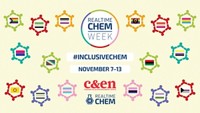Advertisement
Grab your lab coat. Let's get started
Welcome!
Welcome!
Create an account below to get 6 C&EN articles per month, receive newsletters and more - all free.
It seems this is your first time logging in online. Please enter the following information to continue.
As an ACS member you automatically get access to this site. All we need is few more details to create your reading experience.
Not you? Sign in with a different account.
Not you? Sign in with a different account.
ERROR 1
ERROR 1
ERROR 2
ERROR 2
ERROR 2
ERROR 2
ERROR 2
Password and Confirm password must match.
If you have an ACS member number, please enter it here so we can link this account to your membership. (optional)
ERROR 2
ACS values your privacy. By submitting your information, you are gaining access to C&EN and subscribing to our weekly newsletter. We use the information you provide to make your reading experience better, and we will never sell your data to third party members.
Environment
Celebrating IYC 2011
by Rudy M Baum
June 27, 2011
| A version of this story appeared in
Volume 89, Issue 26
The International Year of Chemistry is already half over! And what a year it’s been so far. But there’s more to come. This week’s issue of C&EN is our major contribution to the IYC 2011 celebration. The issue contains five essays by prominent figures in the chemistry enterprise on some of the many ways chemistry is contributing to the welfare of humanity, as well as an essay on the life of Marie Curie, who received her Nobel Prize in Chemistry 100 years ago (see page 39).
The issue also contains a Comment by ACS President Nancy B. Jackson that focuses on IYC 2011 (see page 73). Jackson outlines some of the challenges humans face, and writes, “Although no one knows exactly how to address these challenges, we all agree that collaboration and chemistry are crucial in our search for solutions.”
For Jackson, “collaboration” means working with chemists from around the world, from developed and developing countries. “Chemical scientists from developing and emerging countries have so much to offer the U.S. chemical community,” Jackson writes. She points, for example, to access to natural products and creative applications of green chemistry.
“But most striking,” Jackson writes, “is the personal and professional inspiration that I consistently find through knowing chemists from Africa and other developing regions of the world. Their dedication, enthusiasm, and vision convince me that chemistry really can make the world a better place.”
C&EN has been taking note of such chemists during IYC 2011 in a series of profiles of ACS members living and working in places where there are only a few such members. The profiles have appeared in the last issue of each month. So far this year, we have profiled members living in Cuba (where there are a total of six members), Fiji (1 member), Lebanon (13), Burkina Faso (2), and Moldova (1). These stories of chemists working as researchers and educators under difficult conditions and with meager resources are truly inspirational.
This week’s issue has a profile of Saida R. Aliyeva, one of eight ACS members living in Azerbaijan (see page 75). Aliyeva’s research focuses on the microbiology of organisms that degrade crude oil and hydrocarbon products in the Caspian Sea. Her ACS membership, which she began as a postdoc at Washington State University, “opens the door to research collaborations overseas and gives me new opportunities to communicate with many scientists,” Aliyeva told C&EN Senior Editor Mitch Jacoby.
ACS has been active throughout IYC. It was one of the sponsors of the IYC kickoff event held at the Chemical Heritage Foundation in Philadelphia in February. Along with Dow Chemical, ACS underwrote a webcast of the event, “Global Challenges/Chemistry Solutions,” which is archived at tinyurl.com/IYCwebcast.
Examples of ACS IYC activities (go to www.acs.org) include the monthly . Each issue features free access to 15 to 20 articles from ACS’s 39 journals and C&EN that illustrate the many ways in which chemistry improves life for people around the world. And “365: Chemistry for Life” features a chemistry highlight for each day of the year. This week’s issue date, which is day 178, for example, features an essay on the origins of the oil industry.
Other organizations are also celebrating chemistry during IYC. The National Science Foundation, for example, has teamed up with NBC Learn and the National Science Teachers Association to create “Chemistry Now,” a weekly online video series that explains the chemistry of everyday molecules like water and chemical principles such as chirality in a clever and easy-to-understand fashion.
If you haven’t already done so, it’s time to jump on the IYC bandwagon!
Thanks for reading.





Join the conversation
Contact the reporter
Submit a Letter to the Editor for publication
Engage with us on Twitter